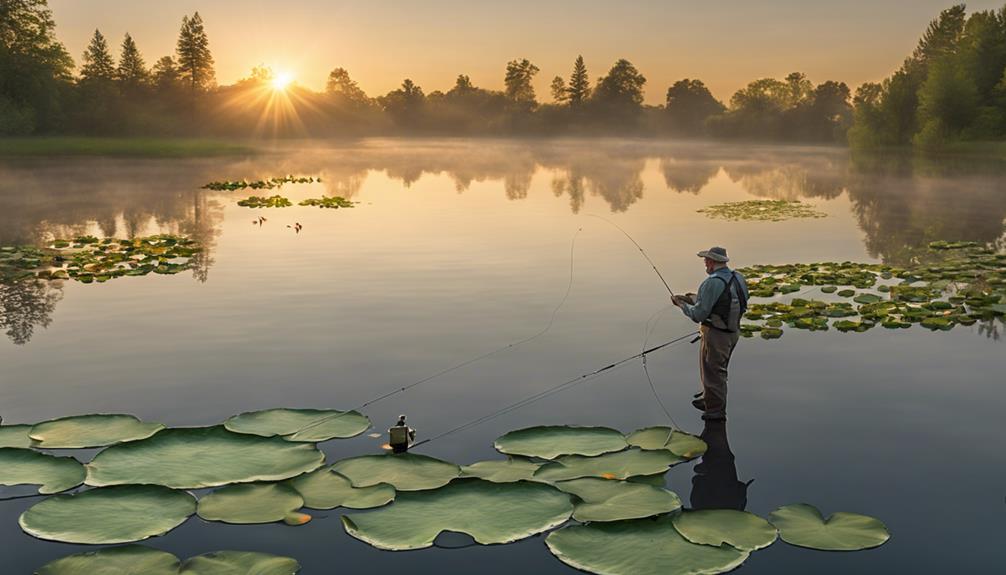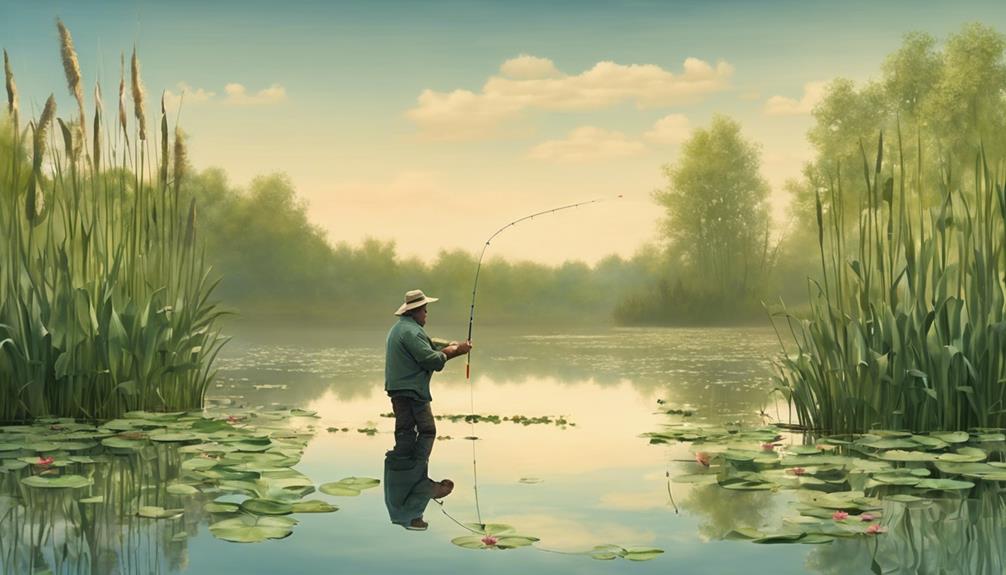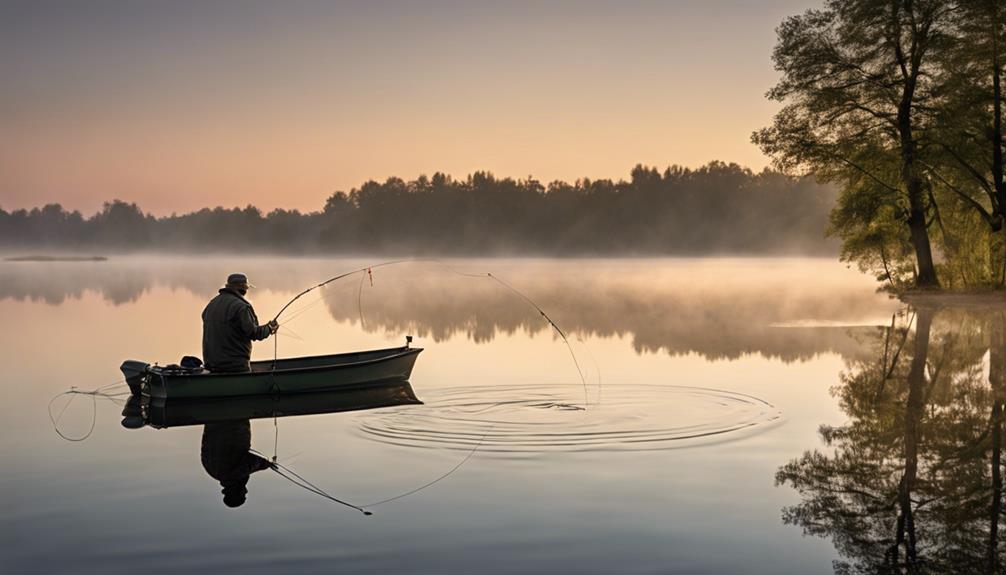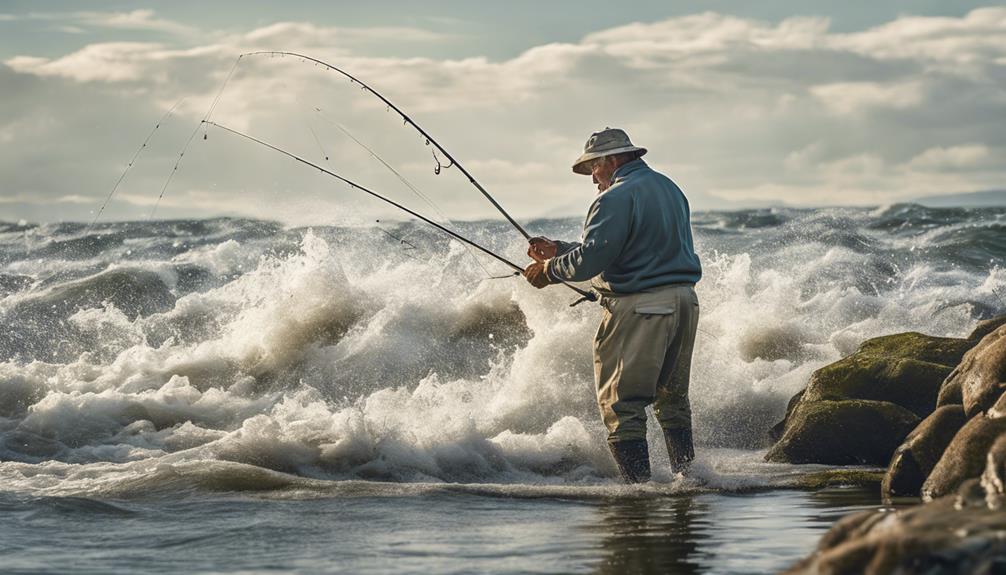When it comes to mastering the art of bluegill fishing, precision is key. From the proper selection of equipment to understanding the behavior of these elusive fish, each step plays a crucial role in your success on the water.
But what if there was a technique that could significantly increase your chances of reeling in those prized bluegills? Stay tuned as we explore a method that will revolutionize your approach to bluegill fishing, setting you apart from the rest with finesse and expertise.
Proper Equipment Selection
When selecting your gear for bluegill fishing, prioritize lightweight rods and reels. For rod selection, opt for a light or ultralight rod to feel the delicate bites of bluegill. A 5-6 foot rod should provide the right balance of sensitivity and control. As for reel options, a small spinning reel works well for bluegill fishing due to its ease of use and versatility in different fishing situations.
When it comes to line strength, choose a light monofilament line in the 2-6 lb test range. Light lines are less visible to bluegill and allow for better presentation of small baits. Additionally, light lines help maintain the fun of the fight with these feisty fish. For hook size, go with small sizes like #6 or #8. Bluegills have small mouths, so using smaller hooks ensures a better hook-up ratio.
Understanding Bluegill Behavior
To increase your success in catching bluegill, understanding their behavior is essential. By knowing how bluegills behave in different situations, you can adapt your fishing techniques accordingly. Here are some key aspects of bluegill behavior to consider:
- Feeding Habits: Bluegills are opportunistic feeders, which means they'll eat a variety of food items such as insects, small fish, and aquatic plants. They're most active during the early morning and late afternoon. Understanding what they feed on can help you choose the right bait to attract them.
- Natural Habitats: Bluegills prefer clear, warm waters with plenty of vegetation for cover. They tend to gather near structures like fallen trees, docks, and weed beds. Knowing where they're likely to be found can increase your chances of a successful catch.
- Spawning Behavior and Water Temperature: Bluegills spawn in the spring when the water temperature reaches around 70°F. During this time, they build nests in shallow waters close to the shore. Being aware of their spawning behavior and the preferred water temperature can help you target specific areas where they're likely to be more active.
Understanding these behaviors can significantly improve your bluegill fishing experience. By observing their habits and adjusting your approach accordingly, you can increase your chances of a successful day on the water.
Choosing the Right Bait
For successful bluegill fishing, selecting the appropriate bait plays a crucial role in attracting these opportunistic feeders. When it comes to bluegill fishing, having the right bait can make all the difference. Artificial lures are a popular choice among anglers targeting bluegill. These lures come in various shapes, sizes, and colors, mimicking the insects and small baitfish that bluegill feed on. They can be used with a casting rod or a fly rod, making them versatile options for different fishing conditions. Additionally, fly tying is a skill that many anglers enjoy mastering to create custom flies that specifically target bluegill.
On the other hand, natural baits like nightcrawlers and mealworms are also highly effective when fishing for bluegill. Nightcrawlers are a classic bait choice that bluegill find irresistible. Their natural movement in the water can attract bluegill from a distance. Mealworms, on the other hand, are smaller and can be used whole or in pieces to entice bluegill to bite. These natural baits can be fished using a bobber or a simple hook setup, making them easy to use for anglers of all skill levels.
Whether you prefer the convenience of artificial lures or the effectiveness of natural baits, choosing the right bait is essential for a successful bluegill fishing trip. Experiment with different baits to see what works best in your local fishing spots and enjoy the thrill of reeling in these colorful and feisty fish.
Mastering the Bobber Technique
Choosing the right bait is crucial, and now let's focus on mastering the bobber technique for maximizing your bluegill fishing success.
When it comes to using a bobber for bluegill fishing, there are a few key techniques you need to master to increase your chances of a successful catch.
- Bobber Placement: The first step in mastering the bobber technique is to ensure you have the right bobber placement. When fishing for bluegill, it's essential to adjust the bobber based on the depth of the water and where the bluegills are likely to be swimming. Start by setting your bobber at a depth where you believe the bluegill are feeding, usually a few feet below the surface. Experiment with different depths until you find the sweet spot.
- Casting Distance: Another crucial aspect of the bobber technique is getting the right casting distance. Bluegill are known to be easily spooked, so casting too close to them can scare them away. Aim to cast your line a few feet beyond where you think the bluegill are lurking. This way, you can slowly reel in your bait towards the target area without disturbing the fish.
- Setting the Hook, Reeling In: Once you see the bobber dip or move, it's time to set the hook. Give a quick but firm tug on your fishing rod to secure the hook in the bluegill's mouth. When reeling in, maintain steady pressure to avoid the fish escaping. Remember to handle the fish gently to ensure a successful catch and release.
Mastering these bobber techniques will undoubtedly improve your bluegill fishing skills.
Utilizing Live Bait Strategies
When fishing for bluegill, incorporating live bait strategies can significantly enhance your chances of a successful catch. Two effective live bait options for bluegill are nightcrawlers and minnows. Nightcrawlers are a classic go-to bait for bluegill. To maximize their effectiveness, present the nightcrawler in a natural and enticing way. One popular nightcrawler presentation method is to thread the worm onto the hook, allowing it to wriggle and move naturally in the water, attracting the attention of bluegill.
On the other hand, minnows can also be a great choice for targeting bluegill. When using minnows as bait, focus on a steady and smooth retrieval technique. Bluegill are more likely to strike at a minnow that's swimming naturally through the water. To achieve this, cast your line and reel in the minnow with a slow and consistent motion, mimicking the movements of a live minnow.
Both nightcrawlers and minnows can be highly effective baits when targeting bluegill. Experiment with different presentation styles and retrieval techniques to see what works best in your fishing environment. Remember, the key to successful bluegill fishing with live bait is to make your presentation as natural and enticing as possible.
Perfecting the Jigging Method
To enhance your success in catching bluegill, mastering the jigging method is essential. Jigging involves moving your bait up and down in the water to attract fish. Here are some key points to perfect your jigging technique:
- Jigging Variations and Best Practices: Experiment with different jigging motions to see what entices the bluegill in your fishing spot. Try a combination of short, sharp jerks and slower, more subtle movements to see what yields the best results. Bluegills can be attracted to various speeds and patterns, so don't be afraid to switch things up until you find what works.
- Jigging Depth: Pay attention to the depth at which the bluegill are biting. Bluegills are known to swim at different depths depending on factors like temperature and time of day. Adjust your jigging depth accordingly to reach the fish where they're feeding. Using a bobber can also help you control the depth at which your bait is presented.
- Timing Strategies: Bluegills are often more active during specific times of the day, such as early morning or late afternoon. By understanding the feeding habits of bluegill in your area, you can time your jigging efforts to coincide with when they're most likely to be actively searching for food. Patience is key, so don't be discouraged if you don't get immediate bites.
Learning the Art of Fly Fishing

Mastering the art of fly fishing requires patience and precision in casting your line to entice bluegill in their natural habitat. Fly fishing is a delicate technique that involves using lightweight artificial lures, called flies, to mimic the insects and small creatures that bluegill feed on. To excel at fly fishing for bluegill, you must focus on two key aspects: fly casting and fly tying.
Fly casting is the skill of presenting your fly accurately and delicately on the water's surface. Bluegill have sharp eyesight and can be easily spooked, so a smooth, controlled cast is essential. Practice your casting technique in an open area before heading to the water. Remember to use a gentle wrist movement and let the line roll out smoothly to avoid scaring away the fish.
Fly tying is another crucial aspect of fly fishing. Tying your own flies allows you to customize the size, color, and pattern to match the specific insects or baitfish found in the bluegill's environment. There are countless resources available to learn different fly patterns, or you can experiment and create your own unique designs. By mastering the art of fly casting and fly tying, you can greatly increase your success in catching bluegill and enhance your overall fishing experience.
Effective Spot Identification
Identifying the most effective spots for bluegill fishing can significantly boost your chances of a successful catch. To enhance your fishing experience, consider the following tips:
- Underwater Structure and Seasonal Patterns: Bluegills are often found near underwater structures such as fallen trees, rocks, and submerged vegetation. These structures provide shelter and attract insects, which are a staple of the bluegill's diet. Understanding seasonal patterns is also crucial. In warmer months, bluegills tend to move to shallower waters to spawn and feed actively. During colder months, they may seek deeper waters for warmth and protection.
- Depth Variations and Water Clarity: Bluegills are sensitive to changes in water depth. They prefer areas with varying depths, as these locations offer a range of temperatures and access to food sources. Pay attention to depth variations when choosing your fishing spot. Additionally, water clarity plays a significant role in bluegill behavior. In clear water, bluegills may be more cautious and easily spooked, requiring a more subtle approach. In murky water, they may rely more on their senses of smell and vibration detection.
Frequently Asked Questions
How Can Weather Conditions Impact Bluegill Fishing Success?
Weather conditions can greatly impact your bluegill fishing success. Factors like fishing pressure and seasonal patterns play a role.
Pay attention to water temperature and moon phases as well. Bluegills may become more active during certain seasons or temperatures, while moon phases can affect their feeding behavior.
Understanding how weather influences these elements can help you strategize for better catches.
Are There Any Specific Techniques for Fishing Bluegill in Murky or Muddy Water?
In murky or muddy water, lure selection is crucial for bluegill fishing success. Opt for bright-colored lures that stand out in low visibility conditions.
Adjust your presentation by slowing down your retrieval to give bluegills more time to spot and strike the bait. Consider using live bait like worms or small minnows to enhance your chances of a bite.
Water clarity directly affects bait choice, so adapt your approach accordingly for a more productive fishing experience.
What Are Some Common Mistakes That Beginner Bluegill Anglers Make?
When you're just starting out with bluegill fishing, there are some common mistakes to watch out for. Avoid using hooks that are too big, as bluegill have small mouths. Also, remember to be patient and not rush the process. Proper techniques include using light tackle and small baits, as well as being observant of the water conditions.
Can Artificial Lures Be Effective for Catching Bluegill, and if So, Which Ones Work Best?
Artificial lures can indeed be effective for catching bluegill. When choosing between live bait and artificial lures, consider the situation and your fishing style.
Some bluegill enthusiasts swear by artificial lures due to their versatility and ability to mimic natural prey. Topwater lures can be exciting to use, especially during active feeding times, while sinking lures are great for targeting deeper bluegill hiding spots.
Experiment to find what works best for you!
How Important Is It to Vary Your Fishing Depth When Targeting Bluegill?
Varying your fishing depth is crucial when targeting bluegill. It's a smart fishing strategy because bluegill tend to swim at different depths based on factors like water clarity and temperature.
Conclusion
Now that you've learned these effective techniques for bluegill fishing, you'll be ready to hit the water with confidence. Remember to select the right equipment, understand bluegill behavior, choose the best bait, and master techniques like bobber fishing, live bait strategies, jigging, and fly fishing.
By identifying productive spots, you'll increase your chances of a successful bluegill fishing trip. Get out there and start reeling in those big bluegills!



